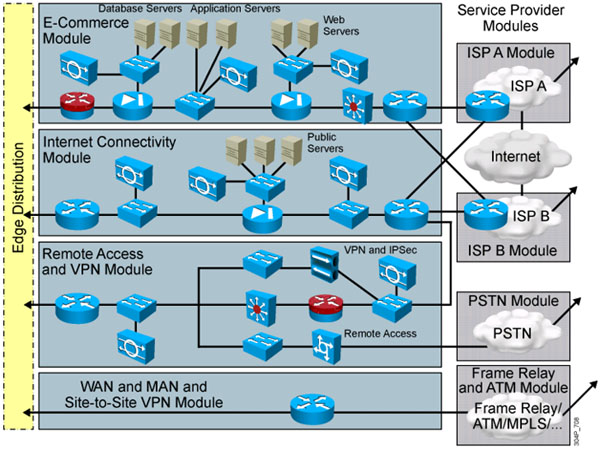Cisco Enterprise Architecture Model
The six modules of the Cisco Enterprise Architecture are:
+ Enterprise Campus module
+ Enterprise Edge module
+ Enterprise WAN module
+ Enterprise Data Center module
+ Enterprise Branch module
+ Enterprise Teleworker module
The purpose of the access layer is to grant end-user access to network resources.
The distribution layer provides aggregation for the access layer devices and uplinks to the core layer. It is also used to enforce policy within the network.
The core layer provides a high-speed, highly available backbone designed to switch packets as fast as possible.
Question 1
Data link switching is typically used in which Enterprise Campus Module layer?A. Server Farm
B. Campus Core
C. Building Access
D. Building Distribution
E. Internet Connectivity
Answer: C
Explanation
In the most general model, the Building Access layer uses Layer 2
switching (or Data link switching), and the Building Distribution layer
uses multilayer switching.
Question 2
Which two statements about designing the Enterprise Data Center Access submodule are correct? (Choose two)A. Multiport NIC servers should each have their own IP address.
B. Layer 3 connectivity should never be used in the access layer.
C. Layer 2 connectivity is primarily implemented in the access layer.
D. Multiport NIC servers should never be used in the access layer.
E. Layer 2 clustering implementation requires servers to be Layer 2 adjacent.
Answer: C E
Explanation
Data link layer switches are often used to connect end devices in the
access layer (while distribution and core layer typically use
multilayer switches -> C is correct.The use of Layer 2 clustering requires the servers to be Layer 2–adjacent -> E is correct.
Question 3
Which two statements about the Enterprise Data Center Aggregation submodule are correct? (Choose two)A. it provides Layer 4 7 services
B. it should never support STP
C. it is the critical point for control and application services
D. it typically provides Layer 2 connectivity from the data center to the core
Answer: A C
Explanation
This submodule provides Layer 4 through Layer 7 services through
security and application service devices such as load-balancing devices,
SSL offloading devices, firewalls, and IDS devices.The Data Center Aggregation (distribution) layer aggregates the uplinks from the access layer to the Data Center Core layer and is the critical point for control and application services.
Question 4
Which of the following is a modular component within the Cisco
Enterprise Campus module in the Cisco Enterprise Architecture framework?A. Teleworker
B. E-Commerce
C. Internet Connectivity
D. Building Distribution
E. WAN/MAN Site-to-Site VPN
Answer: D
Question 5
DataQuirk is a web-based medical transcription company for
exotic-animal veterinarians. The company recently added a third ISP for
international business. They are organizing the enterprise network into
a fully operational Enterprise Edge. To which two modules will the
three ISPs be directly related? (Choose two)A. PSTN
B. E-Commerce
C. WAN/MAN
D. Edge Distribution
E. Internet Connectivity
F. Remote Access VPN
Answer: B E
Explanation
The Enterprise Edge Module consists of the following modules:+ E-commerce module: includes the devices and services necessary for an organization to provide e-commerce applications.
+ Internet connectivity module: provides enterprise users with Internet access.
+ VPN and remote access module: terminates VPN traffic and dial-in connections from external users.
+ WAN/ MAN and site-to-site module: provides connectivity between remote sites and the central site over various WAN technologies.
In these modules, only E-Commerce and Internet Connectivity modules will be directly related to the three ISPs.

Question 6
Which statement decribes the recommended deployment of DNS and DHCP servers in the Cisco Enterprise Architecture Model?A. Place the DHCP and DNS servers in the Enterprise Campus Access layer and Enterprise branch.
B. Place the DHCP and DNS servers in the Enterprise Campus Server Farm layer and Enterprise branch.
C. Place the DHCP server in the Enterprise Campus Core layer and Remote Access/VPN module with the DNS server in the Internet Connectivity module.
D. Place the DHCP server in the Enterprise Campus Distribution layer with the DNS server in the Internet Connectivity module.
Answer: B
Explanation
For the Enterprise Campus, DHCP and internal DNS servers should be
located in the Server Farm and they should be redundant. External DNS
servers can be placed redundantly at the service provider facility and
at the Enterprise branch.
Question 7
Which two modules are found in the Enterprise Edge functional area of the Cisco Enterprise Architecture? (Choose two)A. Teleworker
B. WAN/MAN
C. Server Farm
D. E-Commerce
E. Internet Connectivity
F. Remote Access/VPN
Answer: D E
Explanation
I am not sure about the answers! The Enterprise Edge functional area
consists of four main modules: E-commerce module, Internet Connectivity
module, Remote Access and VPN module, WAN and MAN and Site-to-Site VPN
module. So B and F are correct too. Hope someone will describe this
question clearly after taking the exam!

No comments:
Post a Comment